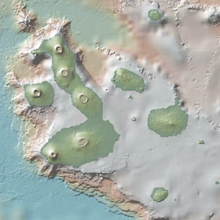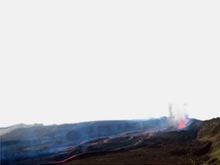
An overview of the Galapagos Islands. They are produced by volcanic activity caused by magma upwelling at the Galapagos hotspot. Large craters can be seen where the most recent eruptions have occurred, including in 2005 at Sierra Negra near the south end of the largest island. Green to white indicates the coastline, outside this is below sea level. Click image for larger view and image credit.
What Is A Hotspot?
Ken MacDonald
Professor, Marine Geophysics
University of California, Santa Barbara
What causes huge volcanic eruptions in the middle of a plate? What causes the Hawaiian Islands, the Galapagos Islands and other island chains? And what causes chains of underwater volcanoes that were once islands?
They are all caused by what we call "hotspot" volcanic activity. This occurs where one of earth's outer tectonic plates moves over an unusually hot part of the earth's mantle. These hot regions are relatively stationary and provide large amounts of melt that rise up, pierce through the plates and produce large volcanic eruptions.
Most hotspots, also known as "mantle plumes," occur beneath oceanic plates; Yellowstone, however, is a good example of a hotspot beneath a continental part of a plate. In Yellowstone, you can see bubbling fumaroles (vents from which volcanic gas escapes into the atmosphere) and hot water geysers like "Old Faithful." There have been gigantic eruptions at Yellowstone in the last two million years that buried most of the United States beneath a steaming layer of volcanic ash.

The Hawaiian Emperor seamount chain is a well-known example of a large seamount and island chain created by hotspot volcanism. Each island or submerged seamount in the chain is successively older toward the northwest. Near Hawaii, the age progression from island to island can be used to calculate the motion of the Pacific Oceanic plate toward the northwest. The youngest seamount of the Hawaiian chain is Loihi, which presently is erupting from its summit at a depth of 1000 m. Click image for larger view and image credit.
A well-known example of a large seamount and island chain created by hotspot volcanism is the Hawaiian-Emperor seamount chain. The younger volcanoes comprise the Hawaiian Islands and include Kilauea volcano, which has been in a continuous state of eruption for over two decades.
Older seamounts in the chain northwest of Hawaii were once also above sea-level, but these former islands became eroded by wave action, and sank beneath the sea surface as the oceanic plate beneath them aged and deepened. Each island or submerged seamount in the chain is successively older toward the northwest. This is because the northwest motion of the oceanic plate carries the islands away until they are too far to continue tapping the deep source of mantle melt. After awhile, a new seamount (and eventually, maybe a new island) is created directly above the mantle melt source.
Near Hawaii, the age progression from island to island can be used to calculate the motion of the Pacific Oceanic plate toward the northwest. Based on this calculation, the plate travels at a rate of about 4 cm/yr relative to the deep mantle melt source. The youngest seamount of the Hawaiian chain is Loihi, which presently is erupting from its summit at a depth of 1000 m.
There is a great deal of debate about the depth below the seafloor from which hotspot lava rises. Some argue that it comes up all the way from the core/mantle boundary, which is about 3000 km (or about 1800 miles) deep, approximately the distance from New York to Miami! Other scientists think the depth may be half this distance, or even less than half, but there is good evidence that the melt comes from at least 700 km (or 300 miles) deep.
In the Galapagos, the most recently known eruption occurred on land, Saturday, October 22, 2005. The eruption occurred at Sierra Negra Volcano on Isabella Island. Very few people live on the island, so no one was killed and damage was minimal.

The most recently known eruption in the Galapagos Islands occurred on land, Saturday, October 22, 2005. The eruption occurred at Sierra Negra Volcano on Isabella Island. A large plume of gases and steam extending approximately 400km southwestwards of the Sierra Negra summit was observed in this photo with NASA satellite imagery on October 25, 2005. Click image for larger view and image credit.
Nearby, deep beneath the sea surface, there are undoubtedly many other volcanic eruptions caused by the vast amount of melt which feeds the Galapagos hotspot. We may even see an eruption while we are at sea in December 2005 and January 2006, and if not, we are sure to see lava flows that erupted during our lifetimes. But will there be abundant hot springs like those at the Yellowstone hotspot? We will have no idea until we get out there and take a close look with the robotic and remotely controlled vehicles we will be using on this expedition. Tune in later to check out what we find!





























